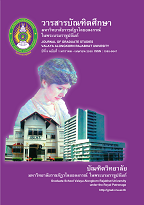ยุทธศาสตร์การพัฒนาการบริหารจัดการการท่องเที่ยวอย่างยั่งยืนตามเส้นทางแอ่งอารยธรรมขอมในภาคตะวันออกเฉียงเหนือตอนล่าง THE DEVELOPMENT STRATEGY OF SUSTAINABLE TOURISM MANAGEMENT ACCORDING TO KHMET CIVILIZATION IN THE LOWER NORTHEAST
Main Article Content
Abstract
บทคัดย่อ
การวิจัยครั้งนี้มีวัตถุประสงค์เพื่อ 1) ศึกษาสภาพปัจจุบันของทรัพยากรการท่องเที่ยว ตามเส้นทางแอ่งอารยธรรมขอม ในภาคตะวันออกเฉียงเหนือตอนล่าง 2) ศึกษาปัจจัยที่มีผลต่อยุทธศาสตร์การพัฒนาการบริหารจัดการการท่องเที่ยวอย่างยั่งยืนตามเส้นทางแอ่งอารยธรรมขอมในภาคตะวันออกเฉียงเหนือตอนล่าง และ 3) เสนอยุทธศาสตร์ในการพัฒนาการบริหารจัดการ การท่องเที่ยวอย่างยั่งยืนตามเส้นทางแอ่งอารยธรรมขอม ในภาคตะวันออกเฉียงเหนือตอนล่าง โดยใช้การวิจัยแบบผสานวิธีแบบคู่ขนานทั้งเชิงปริมาณและเชิงคุณภาพ การวิจัยเชิงปริมาณ ดำเนินการศึกษาโดยใช้กลุ่มตัวอย่าง จำนวน 401 คน ที่เป็นผู้ประกอบการธุรกิจที่เกี่ยวกับการท่องเที่ยว ผู้ปฏิบัติงานในส่วนราชการที่เกี่ยวกับการท่องเที่ยวและนักท่องเที่ยวในจังหวัดนครราชสีมา จังหวัดบุรีรัมย์ จังหวัดสุรินทร์ จังหวัดศรีสะเกษ กำหนดขนาดของกลุ่มตัวอย่าง โดยใช้ตารางของเคร็จซีและมอร์แกน ใช้การสุ่มแบบหลายขั้นตอน เก็บข้อมูลด้วยแบบสอบถามแบบมาตราส่วนประมาณค่า 5 ระดับ ที่มีค่าความเชื่อมั่นเท่ากับ 0.98 วิเคราะห์ข้อมูลด้วยสถิติพรรณนา ได้แก่ ค่าร้อยละ ค่าเฉลี่ย ค่าส่วนเบี่ยงเบนมาตรฐาน และสถิติอ้างอิง คือการวิเคราะห์ถดถอยพหุคูณแบบขั้นตอนการวิจัยเชิงคุณภาพ ใช้การสัมภาษณ์เชิงลึกจากผู้ให้ข้อมูลสำคัญ จำนวน 24 คน จากผู้เกี่ยวข้องกับการท่องเที่ยวภาครัฐ คือ ผู้ว่าราชการจังหวัด และผู้อำนวยการสำนักงานการท่องเที่ยวแห่งประเทศไทย(สาขาจังหวัด) ภาคเอกชน คือ ประธานหอการค้าจังหวัด ผู้ประกอบการเกี่ยวกับการท่องเที่ยว และ ภาคประชาชน คือ นักวิชาการในพื้นที่ ผู้นำชุมชน และประชาชนในพื้นที่ โดยเลือกแบบเจาะจง และการบอกต่อ วิเคราะห์ข้อมูลโดยการอุปมานวิเคราะห์และการตีความ
ผลการวิจัยพบว่า
1) สภาพปัจจุบันของทรัพยากรการท่องเที่ยวตามเส้นทางแอ่งอารยธรรมขอมในภาคตะวันออกเฉียงเหนือตอนล่าง พบว่าโดยรวมและรายด้านอยู่ในระดับมาก ประกอบด้วย ด้านลักษณะทางภูมิศาสตร์ของสถานที่ท่องเที่ยว เอกลักษณ์ทางภาษา รอยอารยธรรม และการสืบทอดทางวัฒนธรรม ภายใต้ความร่วมมือจากภาคเอกชน ภาครัฐ และภาคประชาชน
2) ปัจจัยที่มีผลต่อการพัฒนาการบริหารจัดการทรัพยากรการท่องเที่ยวอย่างยั่งยืนตามเส้นทางแอ่งอารยธรรมขอม ในภาคตะวันออกเฉียงเหนือตอนล่าง ประกอบด้วย (1) คุณลักษณะของนักท่องเที่ยว ได้แก่ ปัจจัยส่วนบุคคล และปัจจัยด้านพฤติกรรมศาสตร์ (2) ทรัพยากรการท่องเที่ยว ได้แก่ลักษณะทางภูมิศาสตร์ของสถานที่ท่องเที่ยว เอกลักษณ์ทางภาษา รอยอารยธรรม และการสืบทอดทางวัฒนธรรม และ (3) การพัฒนาการบริหารจัดการการ ประกอบด้วย การพัฒนา การบริหาร การร่วมมือทุกภาคส่วน การตลาดเพื่อการท่องเที่ยว และการอนุรักษ์ทรัพยากรการท่องเที่ยว โดยปัจจัยทั้ง 3 ปัจจัย ได้แก่ คุณลักษณะของนักท่องเที่ยว ทรัพยากรการท่องเที่ยว และการพัฒนา การบริหารจัดการ สามารถร่วมกันอธิบายความผันแปรของยุทธศาสตร์การพัฒนาการบริหารจัดการการท่องเที่ยวอย่างยั่งยืนตามเส้นทางแอ่งอารยธรรมขอมในภาคตะวันออกเฉียงเหนือตอนล่างได้ร้อยละ 91.30 (R2 = 0.913) อย่างมีนัยสำคัญทางสถิติที่ระดับ .05
3) ข้อเสนอยุทธศาสตร์การพัฒนาการบริหารจัดการการท่องเที่ยวอย่างยั่งยืนตามเส้นทาง แอ่งอารยธรรมขอมในภาคตะวันออกเฉียงเหนือตอนล่าง มี 5 ยุทธศาสตร์ คือ ยุทธศาสตร์ที่ 1 ยุทธศาสตร์การเชื่อมโยงแอ่งอารยธรรมขอมทั้งสี่แห่งอย่างเป็นรูปธรรม ยุทธศาสตร์ที่ 2 ยุทธศาสตร์ความร่วมมืออย่างเป็นรูปธรรมทั้งสามภาคส่วน ภาครัฐ ภาคเอกชน ภาคประชาชน ยุทธศาสตร์ที่ 3 ยุทธศาสตร์การทะนุบำรุงรักษาทรัพยากรการท่องเที่ยวอย่างยั่งยืน ยุทธศาสตร์ที่ 4 ยุทธศาสตร์แหล่งรายได้ของทุกภาคส่วนอย่างยั่งยืน และยุทธศาสตร์ที่ 5 การพัฒนาบุคลากรทุกภาคส่วนที่เกี่ยวข้องกับการท่องเที่ยว
ABSTRACT
The objectives of this study were 1) to study elements of development strategy of sustainable tourism management according to Khmer civilization in the lower northeast, 2) to study the factors affecting the development strategy of sustainable tourism management according to Khmer civilization in the lower northeast and 3) to propose the development strategy of sustainable tourism management according to Khmer civilization in the lower northeast. The approach of this research was a parallel mixed methods of the qualitative and quantitative research. The quantitative research was conducted by studying the samples of 401 respondents who were tour entrepreneurs, tour officials and tourist in 4 provinces including Nakhon Ratchasima, Buri Ram, Surin and Sisaket. The sample size was obtained by the calculation with Krejcie and Morgan’s formula at reliability level of 0.95 by stratified random sampling and multi-stage random sampling. The tool used for data collection was a 5 level rating scale questionnaire at reliability level of 0.98. Statistics used to analyze data were percentage, mean, standard deviation and stepwise multiple regression analysis. The qualitative research conducted by in-depth interviewing the participants for 24 key informants who were experts including governor, director of office of the provincial tourism, Chairman of Provincial Chamber of Commerce, tour entrepreneurs and local leader in 4 provinces which selected by Purposive sampling and Snowball Sampling and analyzed by using content analysis and triangulation.
The research findings were as follows:
1) The development strategy of sustainable tourism management according to Khmer civilization in the lower northeast were (1) civilization linking strategies were factor loading value = 0.876 (2) substantive cooperative strategies of public, private and populace were factor loading value = 0.874, (3) substantive monetization strategies of all sectors were factor loading value = 0.863 and (4) strategies of tourism resource conservation were factor loading value = 0.760. All of these aspects could explained the variation of criteria for development strategy of sustainable tourism management according to Khmer civilization in the lower northeast at 71.334 percent.
2) The factors affecting the development strategy of sustainable tourism management according to Khmer civilization in the lower northeast were
(1) characteristics of tourists including personal factors and behavioral factors,
(2) tourism resource including geography of tourist attraction, linguistic identity, civilization and cultural inheritance and (3) management development including development, management, cooperation of all sectors, marketing for tourism, and tourism resource conservation, which 3 factors including characteristics of tourists, tourism resource, management development could explained the variation of criteria for development strategy of sustainable tourism management according to Khmer civilization in the lower northeast at 91.30 percent (R2 = 0.913) at reliability level of 0.05 (F = 198.292).
3) The development strategy of sustainable tourism management according to Khmer civilization in the lower northeast was input was 3R which mean tourism resource including tourists, Khmer civilization and tourism personnel, the process was 5S which mean 5 strategies were substantive linking strategy of 4 Khmer civilizations, substantive cooperative strategies of government, private and populace, strategies of sustainable tourism resource conservation, sustainable monetization strategies and strategies of tourism personnel development of all sector and the outcome was the tourism of Nakhon Ratchasima, Buri Ram, Surin and Sisaket province was a group of Khmer civilization which had the historical significance, sustainable tourism and had positive outcome for all sector. Finally, tourism personnel, tourist, populace in the tourist area and people who were planned and developed the tourism in own province by using the development strategy of sustainable tourism management according to Khmer civilization in the lower northeast had a better life.
Article Details

This work is licensed under a Creative Commons Attribution-NonCommercial-NoDerivatives 4.0 International License.
บทความทุกเรื่องได้รับการตรวจความถูกต้องทางวิชาการโดยผู้ทรงคุณวุฒิ ทรรศนะและข้อคิดเห็นในบทความ Journal of Global of Perspectives in Humanities and Social Sciences (J-GPHSS) มิใช่เป็นทรรศนะและความคิดของผู้จัดทำจึงมิใช่ความรับผิดชอบของบัณฑิตวิทยาลัย มหาวิทยาลัยราชภัฏวไลยอลงกรณ์ ในพระบรมราชูปถัมภ์ กองบรรณาธิการไม่สงวนสิทธิ์การคัดลอก แต่ให้อ้างอิงแหล่งที่มา


